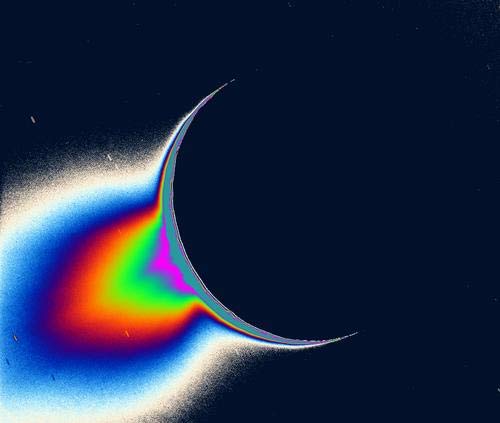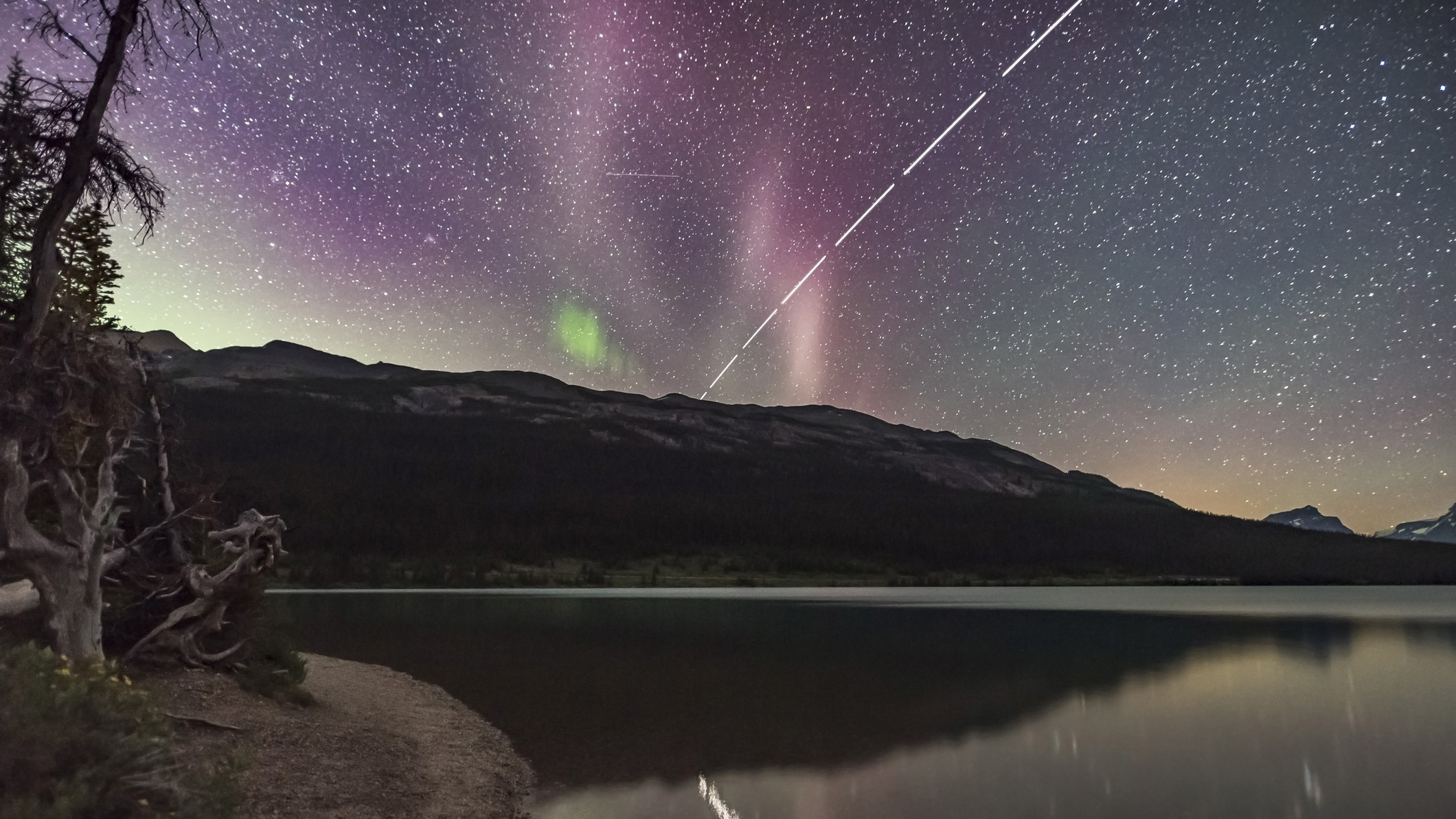Cassini Finds Signs of Liquid Water on Saturn's Moon

This story was updated at 2:52 p.m.EST.
Saturn'smoon Enceladus may have pockets of liquid waterlurking beneath its surface, feeding great jets that spew from the satelliteand hinting at the possibility of a habitable environment, researchers saidThursday.
Observationsfrom the Cassini spacecraft currentlystudying Saturn and its myriad moons shows Enceladus,one of the brightest objects in the Solar System, to be a geologist's dream,with an activeplume spewing water and other material spaceward, as well as a hot spotof thermal activity at its south pole.
"This finding has substantially broadened the range ofenvironments in the solar system that might support living organisms, and itdoesn't get any more significant than that," said Carolyn Porco, Cassini imaging team leader at the Space Science Institutein Boulder, Colorado, in an e-mail interview. "I'd say we've just hit the ballright out of the park."
Porco ledone of nine studies of Enceladus, all of which aredetailed in this week's issue of the journal Science, based on Cassini'sobservations from three flybys past the moon - each closer than the last - inFebruary, March and July of 2005.
Enceladus'activenature points toward subsurface water reservoirs beneath its icy exterior,much like that believed to churn just under the surface of Jupiter's moon Europa, researchers said. But unlike Europa, which researchers believe harbors a vast oceanbeneath kilometers of thick ice, Enceladus' water maybe just below the surface.
"What'sdifferent here is that pockets of liquid water may no more than tens of metersbelow the surface," said Andrew Ingersoll, a Cassini imaging team member andatmospheric scientist at the California Institute of Technology, in a statement.
Breaking space news, the latest updates on rocket launches, skywatching events and more!
Plumescience
Cassinicaught hard evidence of Enceladus' plume since lastyear, though scientists were unsure of what powers the jets of particlesblowing into space. The moon is only the third other body in the Solar System -Earth, Jupiter's moon Io and possibly Neptune's moon Triton are the others -known to have active volcanic processes, researchers said.
Porco'steam found evidence that the jets may erupt from buried pockets of water attemperatures above 32 degrees Fahrenheit (0 degrees Celsius) like a frigidgeyser.
The closeproximity of water, rock and the south pole's thermalhot spot puts Enceladus on the list of possibleharbors for biological activity, some researchers said.
"You've gotliquid water, and it's liquid water interfacing with rock...and there's energy,"NASA Cassini scientist Candice Hansen-Koharcheck toldSPACE.com. "We've got the very most basic ingredients here, and so thatnotches it up on the biological potential list."
Cassini'sinstruments could help pin down Enceladus' liquidwater sources in future passes, researchers added.
"If a wetdomain exists at the bottom of Enceladus' icy crust,Cassini may help to confirm it," writes Jeffrey Kargel,a research scientist with the University of Arizona's Department of Hydrologyand Water Resources, in a related article in Science.
But thespacecraft, Kargel wrote, will not be able todetermine whether subsurface water pockets could offer a habitat suitable forliving organisms.
"Any lifethat existed could not be luxuriant and would have to deal with lowtemperatures, feeble metabolic energy, and perhaps a severe chemicalenvironment," Kargel wrote. "Nevertheless, we cannotdiscount the possibility that Enceladus may be life'sdistant outpost."
Othermysteries
Cassini's Enceladus flybys also answered other questions surroundingthe role of the moon's plume in the near-Saturn environment.
The plume,which a team of researchers led by Hansen-Koharcheck at the Jet Propulsion Laboratory in Pasadena,California believe may have been erupting continuously for 15 years, appears toreplenish Saturn's E-ring with material and provide the source of oxygen andhydrogen permeating the planet's neighborhood.
"It'sdefinitely the water, there's no doubt about it," Hansen-Koharchecksaid, adding that trace amounts of other materials are also present in theplume.
Cassinideputy project scientist Linda Spilker told SPACE.comthat the plume activity on Enceladus is muchdifferent from the volcanoes on Jupiter's moon Io, where material eventually settlesback on the surface once it erupts. Instead, Enceladusspews material directly into space and Saturn's E-ring.
"If youturned Enceladus off, you would probably turn off theE-ring," Spilker added.
The plume'sactivity appears tied to the thermal hotspot at Enceladus'south pole, the source of that internal heat remainsundetermined.
"We thinkwe can rule out a radioactive related source," said John Spencer, a Cassini scientist with the Southwest Research Institute inBoulder, adding that tidal heating from the gravitational pull of nearby Saturnis a more likely culprit.
Cassini'snext chance to take a close look at Enceladus willoccur in 2008, when the probe will swing within 220 miles (350 kilometers) of thesmall moon, though the probe may have a few long-distance views before then,researchers said.
"We're allgoing to have to patiently wait," Hansen-Koharchecksaid.
- Active Moon of Saturn Excites Astronomers
- Puzzling Hot Spot Found on Moon of Saturn
- Cassini Finds an Atmosphere on Saturn's Moon Enceladus
- Special Report: Cassini's Mission to Saturn and its Moons

Tariq is the award-winning Editor-in-Chief of Space.com and joined the team in 2001. He covers human spaceflight, as well as skywatching and entertainment. He became Space.com's Editor-in-Chief in 2019. Before joining Space.com, Tariq was a staff reporter for The Los Angeles Times covering education and city beats in La Habra, Fullerton and Huntington Beach. He's a recipient of the 2022 Harry Kolcum Award for excellence in space reporting and the 2025 Space Pioneer Award from the National Space Society. He is an Eagle Scout and Space Camp alum with journalism degrees from the USC and NYU. You can find Tariq at Space.com and as the co-host to the This Week In Space podcast on the TWiT network. To see his latest project, you can follow Tariq on Twitter @tariqjmalik.
